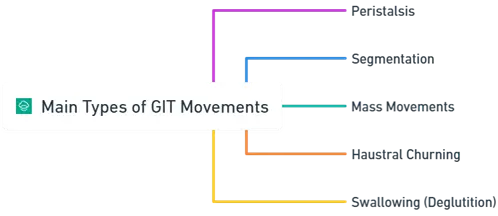- The gastrointestinal tract (GIT) performs a series of coordinated movements to propel food through the digestive system and mix it with digestive enzymes.
- These movements are essential for the effective breakdown, absorption, and elimination of food.

This is a sample ad placement!
The main types of GIT movements are:
Peristalsis:
- Rhythmic, wave-like contractions that propel food through the GIT from the esophagus to the rectum.
- Helps move the bolus, chyme, and fecal matter through the digestive tract.
Segmentation:
- Mixing contractions in the small intestine that divide chyme for better mixing with digestive enzymes and bile.
- Enhances nutrient absorption by bringing chyme into closer contact with the intestinal wall.
This is a sample ad placement!
Mass Movements:
- Large-scale, powerful contractions in the colon that move fecal matter toward the rectum.
- Typically occur a few times a day, often after eating (gastrocolic reflex).
Haustral Churning:
- Occurs in the colon, involving the filling and emptying of haustra (pouch-like structures).
- Aids in the absorption of water and electrolytes from fecal matter.
This is a sample ad placement!
Swallowing (Deglutition):
- A complex reflex that moves food from the mouth to the stomach.
- Begins as a voluntary action and continues involuntarily through the pharynx and esophagus.
Thank you for reading from Firsthope's notes, don't forget to check YouTube videos!

